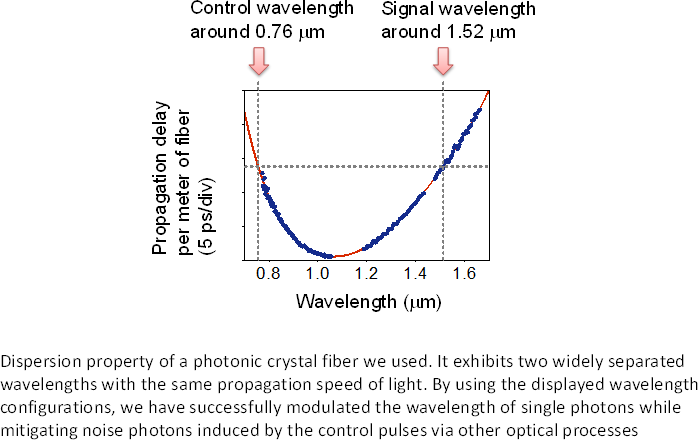Microsoft ends support for Internet Explorer on June 16, 2022.
We recommend using one of the browsers listed below.
- Microsoft Edge(Latest version)
- Mozilla Firefox(Latest version)
- Google Chrome(Latest version)
- Apple Safari(Latest version)
Please contact your browser provider for download and installation instructions.
March 26, 2016
A new scheme for manipulating the color of single photons -- Lossless wavelength conversion of single photons in an optical fiber --
Nippon Telegraph and Telephone Corporation (NTT, CEO: Hiroo Unoura, Tokyo) has demonstrated a new scheme for the wavelength conversion of a single-photon wave packet required for quantum information-communication technologies. The scheme enables us to deterministically change the color and shape of a single-photon wave packet in a lossless manner. The scheme, directly applicable to single photons travelling in an optical fiber network, will be a key technology toward the development of a photonic wavelength interface for quantum networking.
This work will be published in "Science Advances" on March 25, 2016 (EST). This work was supported by Grants-in-Aid for Scientific Research from the Japan Society for the Promotion of Science (JSPS).
1.Background
Wavelength (frequency, color) is an important physical parameter of light, and wavelength conversion is necessary for current photonics technologies. Applications of wavelength conversion range from simple device like laser pointers to the fields of communications, precision measurement, and biomedical sciences.
Meanwhile, wavelength conversion of single photons is crucial for quantum communication, which holds promise for applications that are intractable with conventional communication, such as quantum cryptography and quantum teleportation. For example, the telecommunications wavelength is the wavelength suitable for the long-distance transmission of photons in optical fiber networks. On the other hand, many physical systems, such as atoms, are sensitive to light with wavelengths in the visible band. In addition, even within the same wavelength band, the wavelengths and spectral shape of photons generally differ from each other depending on physical properties of the photon sources or on the wavelength channel used for the transmission. Hence, the ability to harness the wavelength of photons, ideally in a lossless manner for scalability, is required in order to distribute quantum information between distant sites via interactions between light and matter or another light.
2.Results
To accomplish this, NTT developed a lossless scheme for the wavelength conversion of photons. We utilized an all-optical effect called cross-phase modulation (XPM). XPM enables us to control the phase of light (signal pulses) via a change in the refractive index of a medium induced by another light (control pulses). When the refractive index varies dynamically, frequency modulation is induced to the signal field as a result of a signal's non-uniform phase shift. By using single photons as the signal field, we can modulate the wavelength of the photons (Fig. 1). Since XPM always occurs regardless of the intensity of the control field, the wavelength conversion occurs without a photon loss. This is in contrast to the conventional all-optical wavelength conversion scheme for photons, namely nonlinear frequency mixings, where an intense control field is required for high conversion efficiency.
Wavelength conversion using XPM has been widely demonstrated for classical optical pulses; however, it has not yet been demonstrated for single photons. This is because it was difficult to add a wavelength shift to single photons while mitigating noise photons induced by the control pulses via other optical processes. We solved this problem by using a photonic crystal fiber whose dispersion property was properly designed for the experiment (Fig. 2). As a result, we were able to successfully convert the wavelength of telecommunication-band single photons as shown in Fig. 2. We have obtained a wavelength shift as large as 3nm (0.4THz in frequency), demonstrating the applicability of our scheme to, for example, the tuning of the photon wavelengths in disparate wavelength-division-multiplexing channels in the optical fiber network. The amount of the wavelength conversion can be easily tuned by adjusting the intensity of the control pulses. Photon loss due to the conversion was not observable. Thus, XPM can provide a photon wavelength converter with minimized communication cost due to a photon loss.
Using the scheme, we further controlled the quantum correlation of pairs of photons. The demonstrations include the modulations of non-classical frequency correlation (Fig. 4), interference, and entanglement between distant photons. These results demonstrate our scheme's applicability to a wide range of quantum information science and technologies, including computation and metrology.
3.Outlook
We are attempting to further improve the bandwidth and the controllability of the wavelength conversion. This can be achieved by further engineering the dispersion property of the photonic crystal fiber or engineering the temporal shape of the control pulses. The scheme, achievable in an optical fiber, is compatible with the equipment in optical communications networks. Based on this feature, we aim to develop a photon wavelength interface for flexible quantum networking.
Publication information
N. Matsuda, "Deterministic reshaping of single photon spectra using cross phase modulation,"
Science Advances (2016).
Fig.1 Single-photon wavelength conversion in an optical fiber

Fig.2 Dispersion property of the photonic crystal fiber

Fig.3 Results of single-photon wavelength conversion

Fig.4 Control over spectral correlation of twin photons

Contact information
Nippon Telegraph and Telephone Corporation
Science and Core Technology Laboratory Group, Public Relations
a-info@lab.ntt.co.jp
Information is current as of the date of issue of the individual press release.
Please be advised that information may be outdated after that point.
NTT STORY
WEB media that thinks about the future with NTT











